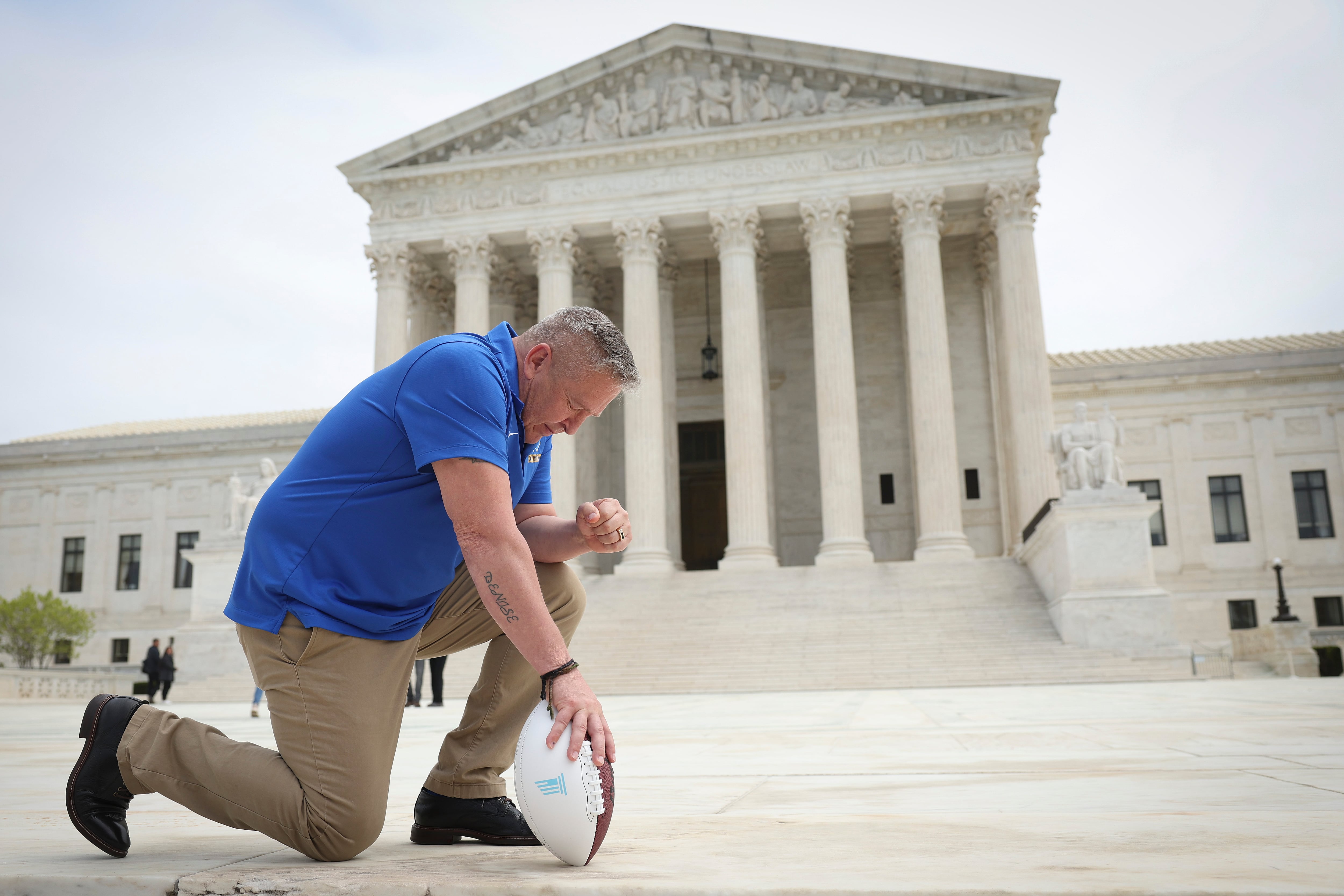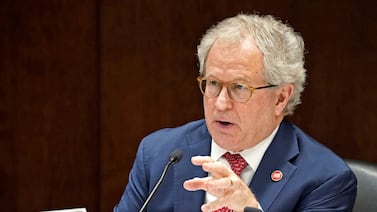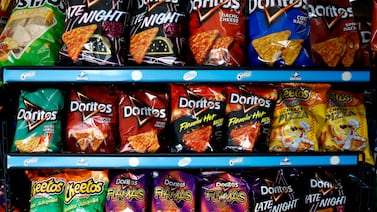A Washington State school district cannot bar a coach from personally but prominently praying at the 50-yard line after a high school football game, the Supreme Court ruled Monday.
“The Constitution and the best of our traditions counsel mutual respect and tolerance, not censorship and suppression, for religious and nonreligious views alike,” Justice Neil Gorsuch wrote for the six Republican-appointed judges.
It’s the court’s latest move to protect religious freedom in education — and bypass concerns about separation of church and state. Just last week the conservative majority also said that religious schools cannot be singled out for exclusion from public funding.
But the decision raises nearly as many questions as it does answers, including what sorts of limits on religious expression in schools are allowed and where the court is headed next. Here’s what we know:
What did the court rule?
Public schools generally cannot bar their employees from conducting a “private” and “personal” religious expression while on the job, a 6-3 Supreme Court majority said.
In this case, assistant football coach Joseph Kennedy must be allowed to pray after football games even if the public will see him doing so, the court said. Kennedy had lost his job after refusing the school district’s directive to pray out of public view.
“Here, a government entity sought to punish an individual for engaging in a brief, quiet, personal religious observance,” wrote Gorsuch. “The Constitution neither mandates nor tolerates that kind of discrimination.”
Wait — what does “private” and “personal” mean here?
It’s complicated, and this was a key issue in this case. The district argued that the coach’s prayer was not private for several reasons: Kennedy was sometimes joined by players from the team, the prayer occurred while he was still on the job, and it was high profile, garnering widespread attention in the community.
But the majority ruled that the prayer was in fact private because the coach never asked or mandated his players to join and it wasn’t “within the scope of his duties as a coach.”
“He was not instructing players, discussing strategy, encouraging better on-field performance, or engaged in any other speech the District paid him to produce as a coach,” wrote Gorsuch.
The opinion also pointed out that other coaches took breaks from their job after the game to mingle with family or make a phone call; punishing Kennedy for praying amounts to singling out religion for unfair treatment.
The opinion analogizes the prayer to other personal but publicly visible expressions of religious adherence.
If any noticeable religious expression were considered a public endorsement, wrote Gorsuch, “a school could fire a Muslim teacher for wearing a headscarf in the classroom or prohibit a Christian aide from praying quietly over her lunch in the cafeteria.”
The dissent by Justice Sonia Sotomayor scoffed at the idea that the high-profile prayer was really private, even including pictures of Kennedy praying while surrounded by players.
“This case is not about the limits on an individual’s ability to engage in private prayer at work,” she wrote for the three Democratic-appointed justices. “This case is about whether a school district is required to allow one of its employees to incorporate a public, communicative display of the employee’s personal religious beliefs into a school event.”
So does this mean public schools can, say, require prayers again?
No — the opinion suggests that schools and coaches still can’t conduct public prayer or religious expression that requires students to participate.
In this particular case, Kennedy had led prayer with students in the locker room and held religiously inspired pep talks after the game. But the coach’s lawyer did not defend these practices and the court seems to concede that those would not be allowed. Only his “private” prayer — while not acting in his capacity as a coach — is protected, the decision suggests.
“The only prayer Mr. Kennedy sought to continue was the kind he had started out doing at the beginning of his tenure — the prayer he gave alone,” wrote Gorsuch.
Gorsuch also seemed to reiterate prior decisions banning schools from broadcasting a student-led prayer over the public address system before a football game or having a rabbi deliver a prayer during a high school graduation ceremony.
What about concerns that players might feel like they had to join even a “private” prayer?
Gorsuch suggested that this is a legitimate concern in theory, but that it wasn’t an issue in this particular case. He emphasized that Kennedy’s final three prayers — which ultimately triggered the district suspending him — did not involve any players from his team.
Not so fast, countered the dissent. This ignores subtle pressure that students might face to join the prayer and the fact that Kennedy had at times conducted prayers with most of the team present, Sotomayor said.
The majority opinion, she wrote, “applies a nearly toothless version of the coercion analysis, failing to acknowledge the unique pressures faced by students when participating in school-sponsored activities.“
Sotomayor also pointed out that some parents had said their children had felt pressure to join their teammates in some of Kennedy’s prayers. Gorsuch dismissed that as hearsay, and a remnant of the more public prayers that Kennedy had agreed to stop.
How do schools know what sort of religious practices are and aren’t allowed now?
That may prove tricky, and will likely depend on a complex set of factors and legal rules that the Supreme Court hasn’t fully fleshed out.
The bottom line is that schools will have a hard time limiting private religious expression on the job, particularly when staff have down time of any sort. Of course, as discussed, the distinction between public and private is not always clear.
It seems like schools will still be able to stop religious acts that pressure students to join — say, starting class with a prayer. But the bar for what constitutes undue pressure may be fairly high.
Schools cannot bar religious expression just because it might appear to some that the school is “endorsing” religion. This has been used in previous cases, but Gorsuch firmly rejected this logic.
Instead, Gorsuch said that schools should look to “historical practices and understandings” to determine whether a given act runs afoul of the separation of church and state, citing a 2013 decision that allowed a town council to start meetings with a prayer.
Sotomayor predicted significant confusion in response to this decision.
“How will school administrators exercise their responsibilities to manage school curriculum and events when the Court appears to elevate individuals’ rights to religious exercise above all else?” she wrote. “Today’s opinion provides little in the way of answers.”
What does this say about the Supreme Court and its approach to religion and schools?
This is part of the court’s recent march to make schooling more accommodating to religion and religious expression.
While prior courts have placed a greater emphasis on drawing a clear line between church and state, the conservative majority has focused more on protecting the rights of religious adherents — including providing public dollars for religious schools or, as in this case, allowing high-profile religious acts from a school employee.
“Respect for religious expressions is indispensable to life in a free and diverse Republic — whether those expressions take place in a sanctuary or on a field, and whether they manifest through the spoken word or a bowed head,” wrote Gorusch.
In her dissent, Sotomayor claims the majority “yet again” gave “short shrift to the … prohibition on state establishment of religion.”
“The Court sets us further down a perilous path in forcing States to entangle themselves with religion, with all of our rights hanging in the balance,” she concluded.
What related issues might the Supreme Court take up next?
Future federal religion and schools cases could focus on:
- whether charter schools can be religious
- whether private schools that receive public dollars can be barred from discriminating based on sexual orientation or gender identity
- whether public school teachers can be required to use the preferred pronouns of transgender students, if doing so violates their own religious beliefs, and
- whether states can bar all private schools from receiving government aid.
Practically, what will this mean for my school?
School staff may have more freedom to express their personal religious beliefs at school or school events, although just how far this freedom extends isn’t clear.
School district officials will likely face continued legal ambiguity over what is and isn’t allowed. But the latest case could lead them to be more concerned about violating individuals’ religious freedom than violating the separation of church and state. That could lead officials to err on the side of allowing certain religious expressions that they might have otherwise tried to limit.
Matt Barnum is a national reporter covering education policy, politics, and research. Contact him at mbarnum@chalkbeat.org.





